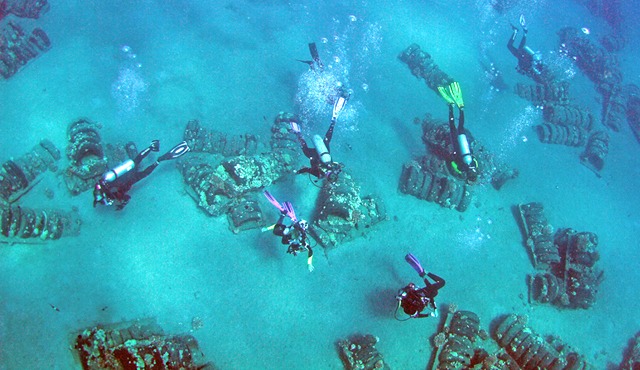
DIVERS DIVING AMONG TIRE MODULES AT THE Keawakapu ARTIFICIAL REEF, MAUI. JUNE 22, 2013. PHOTO: P. FIENE.
If not for automobiles, a popular artificial reef in waters off of Kihei, Maui would not exist. If you’ve been to the Keawakapu artificial reef, you know that this site is made up of about 2,000 automobile tire modules. These modules were constructed by putting 8 tires next to each other on edge and setting them in a concrete base. When these modules were pushed into the water off of a barge in 1979, 1989 and 1990 there were suddenly thousands of tubular shelters and other spaces in which fish and other animals could take shelter.
But, 17 years before the deployment of these tire modules, the artificial reef began with actual automobiles! Here’s how that all came about.
Already in the 1950s, fishermen and fisheries biologists were aware that numbers of fish had declined significantly on Hawai‘i reefs. We are used to hearing about reduced numbers of fish today, but seventy years ago people were already aware of this decline. Fisheries officials decided that building artificial reefs could potentially increase numbers of fish for fishermen.
Scientists determined that areas of open sand in deep enough water to have little surge action were ideal artificial reef sites. The area off Keawakapu in 60-70 feet of water fit these criteria and so a 54-acre site was designated. At that time junked cars were an available resource for building an artificial reef. So in 1962 150 junked cards were prepared on O‘ahu for the project. Fluids were drained and tires and batteries were removed. Some were gutted and were just shells. Given that today’s artificial reef is made up of mostly tires, it may seem ironic that tires were removed from the junked cars. But if the tires had remained on the cars they would have become loose once the rims had deteriorated, allowing them to shift around and damage any natural habitat.
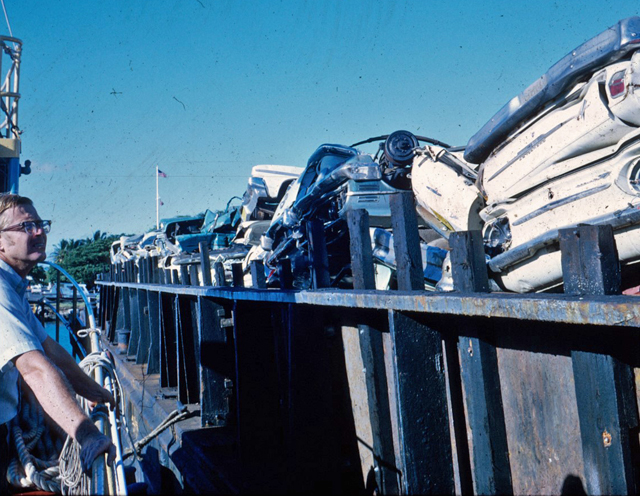
Biologist inspecting cars on barge for deployment. O‘ahu. Date unknown. Photo provided by Paul Murakawa, DLNR, Div. of Aquatic Resources.
In August of 1962 the car bodies were loaded onto a chartered barge on O‘ahu and towed from Honolulu to Maui. Then the cars were pushed off the barge most likely by an excavator (pers. comm. Paul Murakawa) within the designated area where they landed on the sand. This was the beginning of Maui’s first and only official artificial reef.
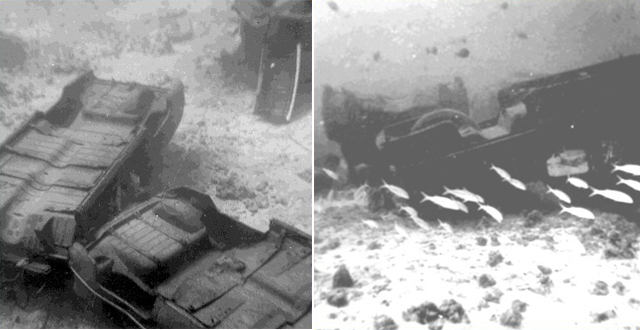
Car bodies underwater. Location unknown. Probably O‘ahu (pers. comm. Paul Murakawa). Photos provided by Paul Murakawa, DLNR, Div. of Aquatic Resources.
While the car bodies lasted the reef was considered a success. DLNR conducted 10 surveys there from 1963-1966 and documented a 6-fold increase in fish species (from 6 species pre-cars to an average of 25 species). There was also a 73-fold increase in pounds per acre (from 3 ppa pre-cars to an average of 222 ppa).
By the time I began diving here in 1987, 25 years after they were sunk, the car bodies had completely rusted away. Only a few car frames were visible, and they were flush with the sand. There was very little vertical structure left in which animals could take shelter. It was a short-lived attempt at artificial reef-building, and a good lesson for the future.
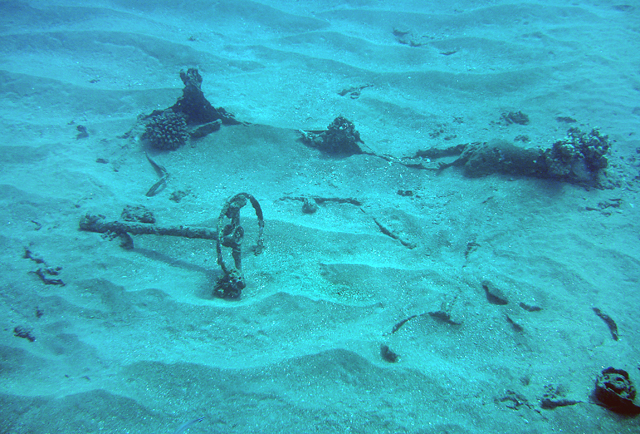
Remaining parts of a car body, Keawakapu artificial reef, April 3, 2017. Photo by P. Fiene.
Amazingly, today, almost SIXTY years after the cars were deployed, some parts are still visible. Although the shifting sands have buried nearly all evidence of the endeavor, a few frames and a couple of steering wheels are still exposed.
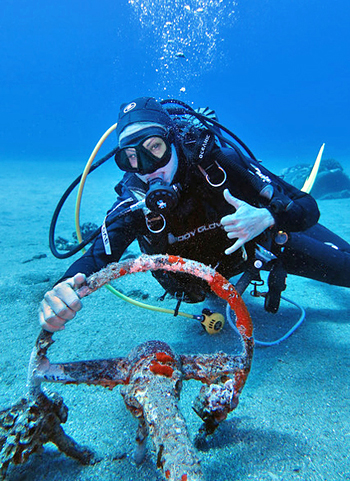
Dive guide Autumn (AJ) Hill with steering wheel at Keawakapu artificial reef. April 25, 2018. Photo by Blaze Anderson.
With hiding places always in demand, even these remnants have a few animals in residence – a tiny lionfish here, a leaf scorpionfish there. Life seems determined to colonize any exposed surfaces – such as the thin layer of red sponge growing on the remaining steering wheels. This shows the resilience of sea life in our oceans and should encourage us to continue to find replacements for natural habitat that has been and will be lost in the future due to climate change.
The automobiles were a good practice run in building an artificial reef in the 1960s. In their place now are the 2,000 plus tire and concrete modules (which appear to have barely deteriorated in the 41 years they have been underwater) and a 65-foot fishing boat, the St. Anthony, which was sunk in the area in 1997.
Written by Pauline Fiene. Photos as credited. Thanks to Russell Sparks, Aquatic Biologist, Hawai‘i DLNR/Div. of Aquatic Resources for providing source information and Paul Murakawa, Aquatic Biologist, Hawai‘i DLNR/Div. of Aquatic Resources for providing source information and wonderful old photos. And to Blaze Anderson, thank you for the classic photo of AJ.
**********
Kanayama, R.K. and E.W. Onizuka. 1973. Artificial reefs in Hawai‘i. Fish and Game Report No. 73-01. Division of Fish and Game, Department of Land and Natural Resources, State of Hawai‘i. 23p.

Comments 3
Thank you, Mike Severns Diving, for sharing this article. Let’s hope Maui continues to implement inventive ways to protect more fish!
Thank you, Mike Severns Diving, for sharing this Maui scuba diving article. Let’s hope Maui continues to implement inventive ways to protect more fish! Happy diving!
Pingback: Triton's trumpet rescue – how long can a Triton's trumpet live without eating?